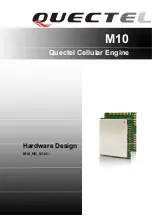
ECM SYSTEM
WG1605-G-E3,WG1605-L-E3,WG1605-GL-E3, DM
1-20
No Start
Checks
Action
DEFINITION: The engine cranks OK, but does not start.
Preliminary Checks
• Refer to Important Preliminary Checks.
Battery and Voltage Check
• Check the battery charge condition.
• Check the battery cranking voltage, voltage less the 9.00 V are outside the parameters of
operation.
• Check Battery positive and negative cable ends for corrosion build up.
Control Module Checks
• Check the inline fuse in the ECM battery power circuit. Refer to Engine Controls Schematics.
• Check battery power, ignition power, and ground circuits, to the ECM.
Refer to Engine Control Schematics. Verify voltage and/or continuity, for each circuit.
Sensor Checks
• Crank sensor.
• Cam sensor.
Fuel System Checks
IMPORTANT
•
A closed LPG / natural gas manual fuel shut off valve, will create a no start condition. Check
the fuel supply line connection to ensure the Excess flow check valve has not set
• Check for air intake system leakage, between the mixer and the throttle body.
• Verify proper operation, of the low pressure lock-off solenoids.
• Fuel filter plugging.
• Check the fuel system pressures. Refer to the LPG / Natural Gas Fuel System Diagnosis.
• Check the low pressure fuel supply hose for restrictions and or blockage.
• Check for restrictions in the air intake system.
• Check for large vacuum leaks in the intake system.
• Check for proper mixer air valve operation.
• Check for exhaust pipe or catalyst restrictions.
Ignition System Checks
NOTE
•
LPG / natural gas, being a gaseous fuel, requires higher secondary ignition system
voltages, for the equivalent gasoline operating conditions.
• Check for the proper ignition voltage output.
• Verify that the spark plugs are correct, for use with LPG / natural gas.
• Check the spark plugs, for the following conditions:
–
Wet plugs
–
Cracks
–
Wear
–
Improper gap
–
Burned electrodes
–
Heavy deposits
• Check for loose ignition, coil connections, at the coil.
Engine Mechanical Checks
IMPORTANT
•
The LPG / Natural Gas Fuel system works on a fumigation principle, of fuel introduction,
and is more sensitive, to intake manifold leakage, than the gasoline fuel supply system.
• Check for the following:
–
Vacuum leaks
–
Improper valve timing
–
Low compression
–
Bent pushrods
–
Worn rocker arms
–
Broken, or weak valve springs
–
Worn camshaft lobes
Exhaust System Checks
• Check the exhaust system, for a possible restriction:
• Inspect the exhaust system, for damaged or collapsed pipes.
• Inspect the muffler, for signs of heat distress, or for possible internal failure.
• Check for, possible, plugged catalytic converter. Refer to Restricted Exhaust System Diagnosis.
KiSC issued 12, 2016 A
Summary of Contents for WG1605-E3
Page 1: ...WG1605 E3 DIAGNOSIS MANUAL ECM SYSTEM KiSC issued 12 2016 A...
Page 3: ...I INFORMATION KiSC issued 12 2016 A...
Page 4: ...CONTENTS 1 SAFETY FIRST I 1 INFORMATION KiSC issued 12 2016 A...
Page 8: ...1 ECM SYSTEM KiSC issued 12 2016 A...
Page 10: ...23 Spark Coil Primary DTC 2300 2301 2303 2304 2306 2307 2309 2310 1 228 KiSC issued 12 2016 A...
















































